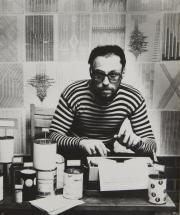
Prigov’s father was an engineer, his mother a pianist. During the war, he lived in evacuation in Sverdlovsk with his parents. After school, he spent two years working in a factory as a metalworker. In 1956, Prigov started writing poetry. In 1966, he graduated from the sculpture department of the Higher Industrial Art School (formerly known as the Stroganov), where his fellow students at the time were the Sots Artists Boris Orlov, Komar and Melamid, Leonid Sokov, and Alexander Kosolapov, artists who later formed the nucleus of Sots Art. In 1966-1974, he worked for the Moscow city architectural department as an inspector overseeing painting of building facades. In 1972, he and Boris Orlov rented a studio, which became a meeting place for artists and poets of the underground. At about the same time, his art practice began in the most advanced movement of Moscow art of the period, Conceptualism. In 1982, together with Victor Erofeyev and Vladimir Sorokin, they formed the EPS group, whose cultural mission was in deconstructing various forms of Soviet ideology by including taboo contexts, particularly “the aesthetics of the body’s bottom,” into the literary sphere. On the eve of Perestroika, he created a street action: the artist pasted up a series of his poems, “Forewarnings,” for which he was hospitalized in a mental institution and released only thanks to the intervention of famous cultural figures. There was never a single official exhibition of Dmitri Prigov in the USSR. He was able to publish his texts in his homeland only starting in 1989, in such journals as Znamia and Ogonyok. Before that, his works were published in émigré journals, such as the almanac Catalog in the USA and the magazine A-Ya in France. In 1991, he became a member of the Russian PEN.
It was only after Perestroika that Dmitri Prigov could travel to Europe. At present his work is widely acknowledged and his texts are studied by Slavists in many countries. His first one-man show was in 1988 at the Struve Gallery in Chicago.
Prigov is one of the most famous figures of the “unofficial art” of the era of the collapse of the Soviet Union. His creative work with its breadth and multidimensionality can be compared without exaggeration to Renaissance universalism. Prigov was a poet, graphic artist, sculptor, creator of installations, performance artist, and culture theorist, who appeared as an actor and vocalist in various film, TV, and musical projects. His literary works and visual art are often inalienably tied to each other. Every public reading of his texts turned into a performance: Prigov used various images of the poet, poet-town crier, poet-hysteric, and poet-prophet, and various ways of reading texts, often in the buffoon mode. His artistic method included mystification, simulationism, travesty, when the artist would first speak in the voice of a propagandist and then as an official, or his lyrical hero would turn into a dull mundane Soviet. Starting in the 1990s, Prigov was involved in creating projects for installations on paper, which he himself called phantoms—numerous series of sketches with ideas for unrealized installations. Prigov was drawn to everything fragile, ephemeral, and using material like newspapers—which he considered a metaphor for human beings with a perishable body but filled with ideas and thoughts—he realized his most large-scale and effective installations (“Kaspar David Friedrich,” State Tretyakov Gallery, 2004).